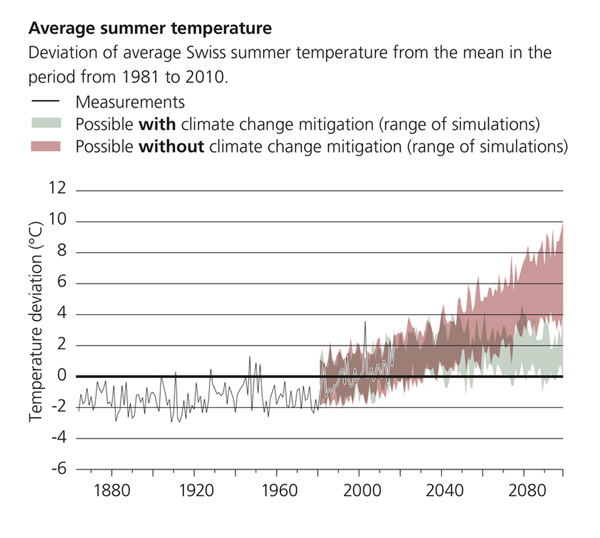Lowering the emissions of greenhouse gases globally could effectively stem climate change. Approximately half of the potential changes in Switzerland’s climate could be avoided by the middle of the 21st century, two-thirds by the end of the century. Although temperatures will still rise in Switzerland, the increases will be much smaller than if emissions are allowed to increase unchecked.

| Possible around mid-century | Possible by the end of the century | |
|---|---|---|
| Temperature Summer | +1 to +2.5 °C |
+1 to +2.5 °C |
| Precipitation Summer | -15 % to +5 % |
-15 % to +10 % |
| Number of very hot days | +0 to +8 |
+1 to +7 |
| 100-year single-day precipitation event in winter** | +5 % |
+5 % |
| Temperature Winter | +0.5 to 2 °C |
+0.5 to 2 °C |
** For changes in heavy precipitation events, only the expected change is given.
Thanks to a concerted joint effort, the signatory countries have achieved the main target of the Paris Climate Agreement. This also has the effect of mitigating climate change in Switzerland: In summer, the temperatures here are about 1.5 °C warmer than before. However, without any effective mitigation measures, this increase would be between 2.5 °C and 4.5 °C.
The aim of the 2015 Paris Climate Agreement is to limit the increase in the Earth’s average surface temperature to well below 2 °C above pre-industrial levels. This global 2-degree target is likely to be achievable if the countries that have signed the agreement urgently reduce their hitherto steadily increasing emissions of greenhouse gases and practically halt them completely in the second half of this century.
Near-surface air temperatures will still increase further despite climate change mitigation – in Switzerland even more so than in the global average. A further increase of about 0.5 to 2.5 °C, depending on the season, is likely by the middle of this century. Added to the climate change already observed,* this results in warming by a total of 2 to 4 °C compared to pre-industrial temperatures.
Amounts of precipitation in summer in our country could decrease by up to 15 percent, and increase in winter by a similar percentage. These figures apply to the middle of the century but would change very little by the end of the century; this indicates that climate change mitigation measures would have a long-term stabilising effect on the climate.
Climate change mitigation will also have an effect on other aspects of climate change in Switzerland: Increases in summer dryness, heat and heavy precipitation events and the lack of snow will be much less pronounced than if emissions were to continue unabated. We could therefore reckon with 10 very hot days per year – instead of over 30 without climate change mitigation.
* The average temperature rose by 1.5 °C between the normal period of 1981–2010 and an early industrial period (1864–1900) (see graph of annual average temperature).
The key messages can also be found in the CH2018 brochure, which is available in printed form or as an electronic download.
Last modification 14.10.2022







